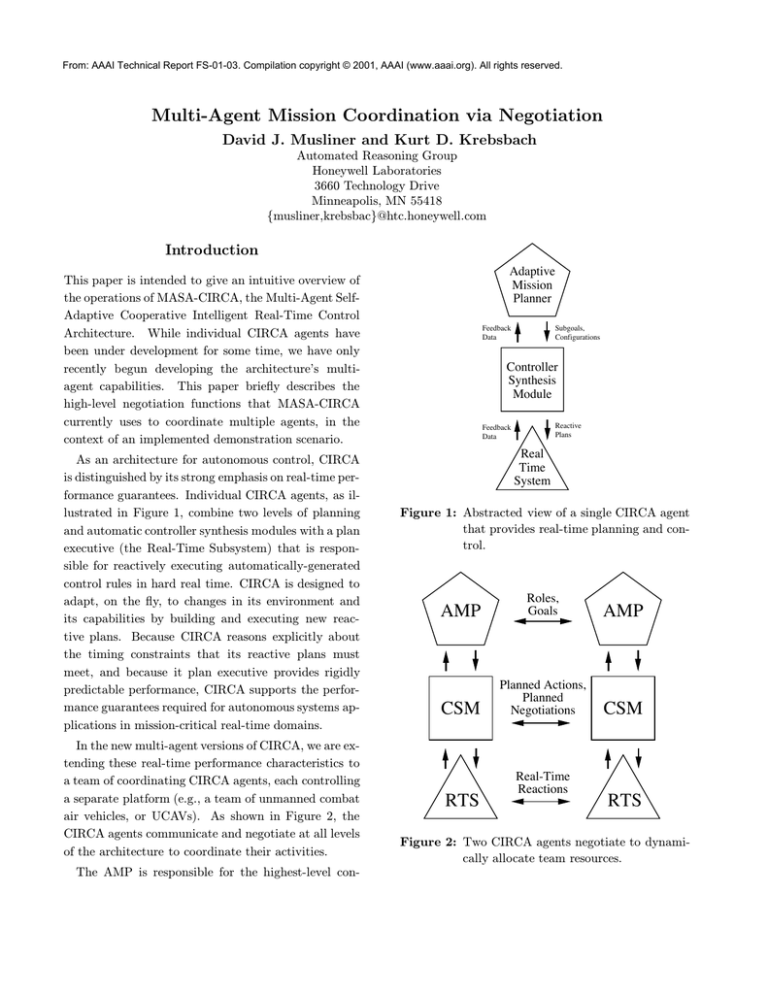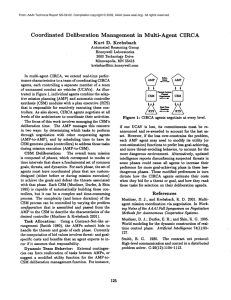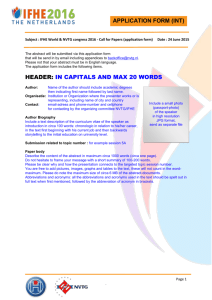
From: AAAI Technical Report FS-01-03. Compilation copyright © 2001, AAAI (www.aaai.org). All rights reserved.
Multi-Agent Mission Coordination via Negotiation
David J. Musliner and Kurt D. Krebsbach
Automated Reasoning Group
Honeywell Laboratories
3660 Technology Drive
Minneapolis, MN 55418
{musliner,krebsbac}@htc.honeywell.com
Introduction
Adaptive
Mission
Planner
This paper is intended to give an intuitive overview of
the operations of MASA-CIRCA, the Multi-Agent SelfAdaptive Cooperative Intelligent Real-Time Control
Architecture. While individual CIRCA agents have
been under development for some time, we have only
recently begun developing the architecture’s multiagent capabilities. This paper briefly describes the
high-level negotiation functions that MASA-CIRCA
currently uses to coordinate multiple agents, in the
context of an implemented demonstration scenario.
As an architecture for autonomous control, CIRCA
is distinguished by its strong emphasis on real-time performance guarantees. Individual CIRCA agents, as illustrated in Figure 1, combine two levels of planning
and automatic controller synthesis modules with a plan
executive (the Real-Time Subsystem) that is responsible for reactively executing automatically-generated
control rules in hard real time. CIRCA is designed to
adapt, on the fly, to changes in its environment and
its capabilities by building and executing new reactive plans. Because CIRCA reasons explicitly about
the timing constraints that its reactive plans must
meet, and because it plan executive provides rigidly
predictable performance, CIRCA supports the performance guarantees required for autonomous systems applications in mission-critical real-time domains.
In the new multi-agent versions of CIRCA, we are extending these real-time performance characteristics to
a team of coordinating CIRCA agents, each controlling
a separate platform (e.g., a team of unmanned combat
air vehicles, or UCAVs). As shown in Figure 2, the
CIRCA agents communicate and negotiate at all levels
of the architecture to coordinate their activities.
The AMP is responsible for the highest-level con-
Feedback
Data
Subgoals,
Configurations
Controller
Synthesis
Module
Reactive
Plans
Feedback
Data
Real
Time
System
Figure 1: Abstracted view of a single CIRCA agent
that provides real-time planning and control.
AMP
Roles,
Goals
AMP
CSM
Planned Actions,
Planned
Negotiations
CSM
RTS
Real-Time
Reactions
RTS
Figure 2: Two CIRCA agents negotiate to dynamically allocate team resources.
trol of a CIRCA agent (Musliner, Durfee, & Shin 1995;
Musliner et al. 1999), managing the agent’s responsibilities (by negotiating with other agents) and the
agent’s deliberation activity. The AMP performs intelligent allocation of deliberation effort via a negotiation and tradeoff process with the Controller Synthesis
Module (CSM) (Musliner 2000). Our current demonstration illustrates early forms of the coordination and
negotiation that occurs between AMPs. Before describing this demonstration, we provide an overview
of the AMP’s operation and brief introduction to the
display systems used to illustrate CIRCA’s operations.
Adaptive Mission Planner Overview
At the highest level, the AMP’s primary responsibility
is managing an individual agent’s tasks and coordinating with other agents to achieve the overall team mission. The AMP does this by determining what tasks
are its responsibilities through negotiation with other
cooperating agents, and then arranging to have plans
(controllers) generated to successfully address those
tasks during the execution of the mission.
The overall team mission is divided into phases,
which correspond to modes or time intervals that share
a fundamental set of common goals, threats, and dynamics. For example, our UCAV scenarios include
missions that have phases such as ingress, attack, and
egress. The ingress phase is distinguished from the attack phase both by the characteristics of the flight path
(e.g., a nap-of-earth stealthy approach vs. a popup maneuver very near a target) and by the expected threats
(e.g., the types of missile threats present at different
altitudes) and goals (e.g., reaching the target zone vs.
deploying a weapon).
In this context, the team of CIRCA agents must
arrange to have different agents responsible for different goals and threats, depending on their available capabilities and resources (e.g., ECM equipment
and weapons loadout). For each mission phase, the
CIRCA agents must have plans, or controllers, that
are custom-designed (either before or during mission
execution) to execute the mission phase and make
the best possible effort to achieve the goals and defeat the threats associated with the phase. The CSM,
described elsewhere (Musliner, Durfee, & Shin 1993;
1995), is capable of automatically building these con-
trollers, but this controller synthesis can be a complex
and time-consuming process. The complexity (and
hence duration) of the CSM process can be controlled
by varying the problem configuration that is passed
to the CSM to describe the characteristics of the desired controller for a particular mission phase (Musliner
2000).
The AMP is thus also responsible for determining
which mission phase the CSM is trying to build a controller for at any moment, and how hard it should work
to do so, by modifying the phase problem configurations. This is what we call the AMP’s deliberation
scheduling function. In the current implementation,
this corresponds to altering which of the phase’s potential goals and threats should be considered. In future
versions, even more flexible techniques will be available
to adjust the CSM problem-solving complexity.
Given a problem configuration, the CSM projects future world states and plans actions that keep the system safe and direct it towards its goals. The CSM also
computes deadlines on these actions, indicating how
quickly they must occur after a particular world state
is reached, to avoid catastrophic failures (e.g., destruction by a threatening surface-to-air missile). The CSM
reduces these action plans to cyclic schedules of TestAction Pairs (TAPs), which test the state of the world
and take a chosen action. The RTS can then execute
these TAP schedules, predictably enforcing the timing
constraints on reaction planned by the CSM to keep
the system safe and achieve its goals.
Inter-Agent Negotiation
Leveraging significant amounts of existing code that we
wrote for an internally-funded project on distributed
scheduling, we have already built and demonstrated
multiple CIRCA AMPs negotiating over the allocation of mission-level responsibilities (e.g., handling missile threats). Using a Contract-Net-like arrangement,
the AMPs submit bids to handle these responsibilities (Smith 1977). Currently the computation of bid
values is artificial, but eventually it will reflect the expected costs and benefits that an agent expects to incur
if it assumes a particular responsibility. For example,
an agent might assign a certain value to planning to use
its electronic countermeasures (ECM) to defeat certain
types of radar-guided missile threats.
Each contract goes through a series of modes as it is
processed by the system:
New — New contracts are formed when an agent
learns of a potential threat or goal for a particular
mission phase. In the current implementation, only
the MASTER learns of new threats and goals. This
simplification was made purely for convenience, and
is not constrained by the current infrastructure. The
agent that learns of the new threat or goal forms a
new contract object and broadcasts an announcement of its contents to all the agents. The agent is
termed the contractor agent for that contract.
Announced — Once a contract is announced, each
agent is responsible for replying with a bid that is
used to determine which agent will assume responsibility for the contract. Currently, bids are essentially pre-specified in the domain description that
indicates which agent can accomplish which types of
tasks. For example, a domain description may say
that a certain agent is highly capable of handling a
particular type of threat, and it should bid a certain constant value (e.g., 10). In the future, the bid
will be computed by more complex methods that assess the agent’s capabilities, physical resources, load
level, and ability to compute a new controller in time.
Awarded — Once the contractor agent receives all of
the bids for a particular contract, it awards the contract to the highest bidder, notifies the other agents
they are not the winner, and updates the contract
status.
Planned-for — The agent that is awarded a new
contract is responsible for building a new controller
that can handle the corresponding new threat or
goal. When the controller synthesis process is complete, the contract status is set to :planned-for.
Completed — Each threat or goal is specific to a
mission phase. When that mission phase has been
completed (e.g., the aircraft has completed the attack phase), the associated threat/goal contracts are
marked :completed.
Failed — If an agent fails to generate a plan for a contract, or it is disabled and thus unable to execute the
controllers it has generated, the contract is marked
failed and the contractor agent re-announces it for
new bids. The re-negotiation proceeds just as with
Figure 3: The AMP Information Display depicts
AMP status.
the original process, so that a new agent is awarded
the contract and builds a controller to handle it.
Currently, the AMPs can negotiate over contracts
that represent responsibility for threats and goals.
When awarded a contract for a threat or goal, the
AMP can then run the CSM to synthesize customized
controllers using CSM problem configurations that are
automatically generated to describe the negotiated responsibilities.
In addition, the AMPs can handle messages saying
that another AMP has died1 , and will issue contracts
to re-negotiate the responsibilities formerly held by the
dead agent. The AMP maintains data structures to
generate and track multiple CSM problem configurations for each mission phase, and it can store the associated controllers generated by the CSM. In addition,
the AMP can download the controllers to the RTS as
soon as they are available.
AMP Information Display
To provide a compact graphical indication of what
functions the AMP is performing, we have developed
an AMP Information Display (AID). The AMP sends
its status information to the AID over a socket. Illustrated in Figure 3, the AID gives the observer visibility into the multi-agent negotiation and planning
processes.
At the top of the AID, two labels indicate which
CIRCA agent the display is describing, and what mission phase that agent is currently executing. Below
1
The underlying socket communications layer inherently
recognizes the loss of connection and returns an error.
those lines, two light bars labeled “IN COMM” and
“OUT COMM” flash when the agent is receiving or
sending over its socket connections to other agents.
Further down, the aircraft icon will display the status
of various aircraft subsystems. This aspect of the AID
is obviously domain-dependent, and it is not fully implemented yet. In the future, we plan to add iconic representations of engines, defensive systems, and other
subsystems subject to damage and imperfect operation. Currently, the only functioning element of the
iconic display is the center diamond, which acts as a
“heartbeat” for the AMP, blinking periodically when
the AMP is idle but still functioning.
Below the iconic display, a set of lines display the
status of each of the contracts in the overall multi-agent
system, according to the single CIRCA agent’s view.
Each contract represents a threat or goal that must be
handled in a particular mission phase. Each line has a
text label identifying the contract it represents, and a
color (not apparent in black-and-white printouts) that
describes the status of the contract:
Red indicates that a new threat/goal contract has arrived and is not yet even announced for bids by other
agents.
Pink indicates that a new contract has been announced for bids, but all the bids have not yet been
received.
Yellow indicates that this agent has been awarded
this contract (i.e., it has accepted responsibility to
“handle” this goal or threat).
Green indicates that this agent has successfully generated a new controller (plan) to handle this contract.
Gray indicates that another agent has responsibility
for this contract.
Purple indicates that this agent was previously responsible for this contract, but is now disabled and
will not handle the associated threat/goal.
As the AMP grows in capabilities, especially in its
ability to make tradeoffs between deliberation time and
the expected performance of synthesized controllers,
we will extend the AID to dynamically visualize these
tradeoffs and give the observer some insight into the operations of the AMP. For example, we expect to have
gauges, graphs, or other intuitive graphical representa-
Figure 4: The RTS Information Display shows what
each RTS is doing at any time.
tions showing performance characteristics such as the
likelihood of failure for different mission phases using
the current-best controllers, etc.
RTS Information Display
The RTS can execute TAPs at extremely high
speeds, so it is very difficult for an observer to follow
its runtime activities. However, it can be very useful
to have some indications of what the RTS is doing. To
that end, we have developed an RTS Information Display (RID). As illustrated in Figure 4, the RID uses
flashing bars of color to indicate each primitive test or
action the RTS executes. As these color bars flicker
rapidly on and off, the observer can recognize different
patterns of RTS activity, and can also discern individual distinct actions that are infrequent. If a pattern of
RTS activity persists for a few seconds, the observer
can also identify specific activities the RTS is performing, by mapping the flashing bars back to the labels on
the left edge of the display.
Recall that the AMP sends its status information
to the AID over a socket. We could have designed
the RTS/RID interactions in a similar way. However,
because that socket communication could add significant overhead to the RTS operations, we have chosen
instead to build this version of the RID directly into
the flight simulation system used for our demonstration. This avoids both additional communication for
the RTS and additional screen real-estate: the RID
is drawn as a “stencil” over the top of the simulation
display.
This approach has one notable weakness: the RID
can only display RTS tests and actions that are sent to
The demonstration scenario contains a flight of five
unmanned F16-type fighter aircraft (MASTER and WING1
through WING4) whose mission is to destroy a ground
target while defending themselves against attack. Figure 5 shows a top-down view of the planned mission
flight path, along with threat and goal location icons.
The mission consists of three phases which correspond
to three distinguished flight path segments: ingress, attack, and egress. During the mission, the AMPs need
to create plans that account for several goals and expected threats:
Figure 5: This mission overlay shows the expected
path with known and unknown threats
and targets.
the simulator (i.e., those that interact with the world
outside of CIRCA); it cannot show the RTS activities
that are purely internal. For example, several TAPs
in every TAP schedule are dedicated to downloading
new TAP schedules, switching between TAP schedules
when a suitable state is reached, etc. These “internal”
TAPs cannot be visualized on the RID embedded inside
the simulator.
For situations where visualizing these internal activities is also important, we have a different version of
the RID available that runs in a standalone mode separately from the simulation environment, but is currently only compatible with Xwindows displays. This
version can show all RTS primitives calls, including internal functions such as reading in new TAP schedules
(controllers).
Demonstration Scenario
Goal
The primary goal of this demonstration scenario is to
illustrate negotiation between CIRCA agents and dynamic generation of controllers on the fly. The demonstration shows the agents negotiating diverse responsibilities and synthesizing customized controllers at the
start of the mission, as well as re-negotiating roles and
dynamically building new controllers during the mission when unexpected circumstances arise.
Mission
1. Defending against IR-guided missile threats during
the ingress phase.
2. Defending against IR-guided and radar-guided missile threats during the attack phase.
3. Destroying the target during the attack phase.
4. Defending against IR-guided missile threats during
the egress phase.
In addition, one unexpected threat is displayed in Figure 5: a radar-guided missile site along the ingress path
that is not reported to the CIRCA agents (presumably
because it is unknown to our forces). This unexpected
threat will turn out to be fatal to WING4, and this leads
to the re-negotiation and replanning activity.
Demonstration Storyboard
When the mission begins, the fighters negotiate responsibilities for the first time. The MASTER is tasked with
defending against radar-guided SAM sites during the
attack phase of the mission. WING1 gets this responsibility during the egress phase. IR threats are handled by WING1 during ingress, WING3 during attack, and
WING4 during egress. Responsibility for destroying the
target is given to WING4. Once plans are constructed
for the initial phases, the aircraft begin flying the mission (even before controllers for the latter phases are
complete).
Before the aircraft leave the runway, controllers have
been generated for all of the mission phases and the
AID shows green lights for all of the goal and threat
contracts. Then, shortly after the aircraft pass over
their first waypoint, the anticipated IR threat attacks.
Figure 4 illustrates the scene where WING1 has been
watching for IR threats and has begun deploying flares
to confuse the incoming IR-guided missile. By repeat-
Figure 6: WING4 exploding.
edly launching flares until the missile explodes on one,
WING1 successfully defeats the IR-guided missile.
A short time later the aircraft pass near the unexpected radar-guided missile site, which attacks. Unfortunately, since we did not tell the CIRCA agents about
this potential threat, they have not built controllers
that look for this danger. Unawares and unresponsive,
WING4 is destroyed (see Figure 6).
The AMPs immediately detect that WING4 is dead,
and re-negotiate its contract responsibilities. WING2
gets the contract for destroying the target and WING3
gets the egress IR threat. Within three seconds the renegotiation process and the new CSM invocations are
complete, and the agents have created new controllers
to handle their altered responsibilities. With all contract lights green (as shown in Figure 7), the team has
recovered and the mission is still headed for success.
The aircraft continue to fly along the ingress flight
route to waypoint four, where they enter the attack
phase. When the target is in range, WING2 fires a
surface-to-ground missile. While that attack missile
is on its way to the target, the fighters are threatened again (as illustrated in Figure 7). This time, the
MASTER leads the flight into evasive maneuvers that defeat the radar-guided SAM. Figure 7 shows the aircraft
at this time. During the evasive maneuvers, the second SAM site near the target launches an IR-guided
missile at the team. In response, WING3 deploys flares
to defeat that missile. The aircraft then proceed safely
to waypoint five. At waypoint five, the flight enters
the egress phase of flight, the CIRCA agents begin ex-
Figure 7: After WING4 dies, the surviving CIRCA
agents re-negotiate and generate new
plans to handle its responsibilities and
ensure mission success. Moments later,
as the attack missile arcs in, the CIRCA
team takes evasive maneuvers to avoid a
rising radar-guided missile.
ecuting a different set of controllers that are concerned
about a different set of threats and goals, and the scenario proceeds without further incident.
Related Work
A wide variety of prior work exists on building multiagent systems that negotiate to coordinate their behavior. As noted earlier, we have used the Contract
Net (Smith 1977) approach almost without change, so
we are not claiming a unique contribution in negotiation methods. Rather, we hope to apply existing methods (and develop new ones as necessary) in a novel context: the hard real-time domains, online controller synthesis, and performance guarantees of CIRCA. The initial demonstration described above has accomplished
part of our objective. While we demonstrated interagent negotiation that impacts CIRCA’s online controller synthesis and runtime performance guarantees,
that negotiation itself has not yet been subjected to the
real-time restrictions and AMP deliberation scheduling
paradigms (Goldman, Musliner, & Krebsbach 2001) we
are developing. In the future, we expect that negotiation with other agents will be just another tool in
the AMP’s kit of possible approaches to trading off
performance and safety (Musliner 2000). When unable to build a fully-guaranteed controller for all of
the goals and possible threats in a particular mission
phase, the AMP may choose to negotiate with other
agents to offload some responsibilities. The time that
this negotiation itself takes will be considered in deciding whether distributed or purely local performance
tradeoffs should be attempted.
Acknowledgments
This material is based upon work supported by
DARPA/ITO and the Air Force Research Laboratory
under Contract No. F30602-00-C-0017. Any opinions, findings and conclusions, or recommendations expressed in this material are those of the authors and do
not necessarily reflect the views of DARPA, the U.S.
Government, or the Air Force Research Laboratory.
The demonstration described in this paper is the result
of work with colleagues including Jeff Rye and Robert
Goldman.
References
Goldman, R. P.; Musliner, D. J.; and Krebsbach,
K. D. 2001. Managing online self-adaptation in realtime environments. In Proc. Second International
Workshop on Self Adaptive Software.
Musliner, D. J.; Goldman, R. P.; Pelican, M. J.; and
Krebsbach, K. D. 1999. Self-adaptive software for
hard real-time environments. IEEE Intelligent Systems 14(4):23–29.
Musliner, D. J.; Durfee, E. H.; and Shin, K. G. 1993.
CIRCA: a cooperative intelligent real-time control architecture. IEEE Trans. Systems, Man, and Cybernetics 23(6):1561–1574.
Musliner, D. J.; Durfee, E. H.; and Shin, K. G. 1995.
World modeling for the dynamic construction of realtime control plans. Artificial Intelligence 74(1):83–
127.
Musliner, D. J. 2000. Imposing real-time constraints
on self-adaptive controller synthesis. In Proc. Int’l
Workshop on Self-Adaptive Software.
Smith, R. 1977. The contract net: A formalism for
the control of distributed problem solving. In Proc.
Int’l Joint Conf. on Artificial Intelligence, volume 1,
472.





